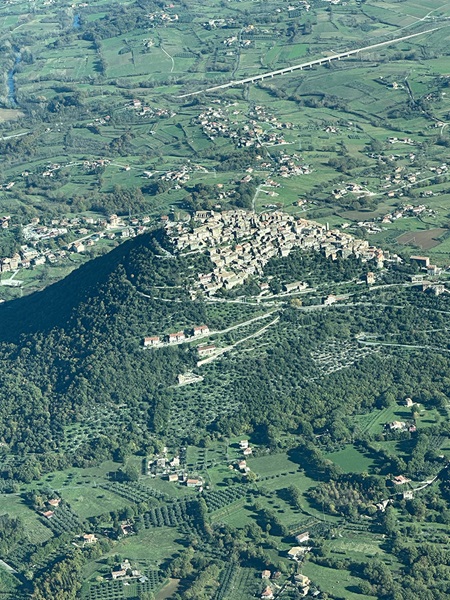Flying over ancestral roots in Italy
Listen to the airplane; it has a story to tell.
That was the advice of veteran pilot Riccardo De Nardis, who flew my wife, Mary Michael, and me over the ancestral homeland of Mary’s parents in the province of Frosinone in west central Italy.
The trek from our pilot’s Sabaudia Flying Club was over the lush Pontine Marshes and Circeo National Park. We reveled as the striking late November colors enhanced the region’s abundant rolling forests of greens, reds, yellows, and browns.
We were grateful for the bright blue skies and mostly calm conditions after days of rain and gusting winds that meant closed runways. November is the wet season in Italy.




We trusted De Nardis and his decades of aviation expertise. It was enriching to renew friendships from 2019.
We also renewed acquaintances with his 1977 Cessna, which De Nardis named La Iena (the hyena). When De Nardis purchased the airplane, it was dusty and smelled like the animal that lives in the African savannah of his home country of Zambia. La Iena needed major cleaning to be operational.

We maintained faith in De Nardis when an unexpected wind gust gave the airplane a sharp jolt with a seemingly several-foot, hair-raising drop. But we wondered what La Iena was trying to tell us.
De Nardis instantly adjusted his flight path—no problem. Nonetheless, I was glad I’d packed extra pants in our car. At my age of 71, who knows.
As with our flight with De Nardis over a nearby area three years prior, we enjoyed the view from about 2,000 feet and its different perspective from ground level.
Ground level can be challenging in Ceccano and especially in Castro dei Volsci, where the upper part of the town is planted on a hilltop that rises about 1,500 feet from the Sacco River valley.
Picturesque, for sure. It is easy to take top-notch photos with the verdant forests and rolling hills.
But the Cessna couldn’t tell us much of Castro’s steep, winding roads and walkways that make for challenging living and sightseeing. Mary and I joke that mountain goats wear oxygen tanks and hiking boots.
Steps aside, Mary and I were thrilled to be among many of her paternal Micheli cousins. In fact, Mary was ecstatic during our numerous dinners and evenings with family.
Family surname Micheli was changed by Ellis Island officials to Michael when her grandfather, Domenico Micheli, emigrated to the United States in 1913. Domenico settled in Sharpsville, Mercer County, Pennsylvania. Mary and I still live in Sharpsville. Her grandfather was one of 10 children; many Micheli offspring reside in Ceccano.





Destination cooking villa Casa Gregorio was our home in Castro for three weeks. During prior visits in 2013 and 2019 we befriended its developer and owner Gregory Aulensi, a Michigan native with dual citizenships in the United States and Italy. Gregory’s father, Angelo Aulensi, was born in Castro.
Aulensi discovered an abandoned seventeenth-century, 12,000-square-foot structure during a 2006 visit, bought it, sank lots of time and money in state-of-the-art restorations, and opened for business in 2010. He acquired additional neighborhood properties in 2015, renovated them, and expanded cooking experience options in 2016.
Castro government and tourism officials in mid-November presented Aulensi with an Award of Excellence for his leading role in attracting tourists from around the world. Casa Gregorio has hosted thousands in luxurious style during its nine-month annual tourist season over the years.
Aulensi also provides many jobs to local residents not only at Casa Gregorio but through nearby businesses such as La Ferriera winery; Vincenzo Di Folco olive grove; a butcher shop; and a bakery that guests visit during their week of cooking, dining, and touring. Patrons get an up-close view of daily life in the region along with cooking and baking experiences.
An Italian-American Thanksgiving feast was a highlight of our stay. Per the Casa Gregorio tradition that no guest ever goes hungry, Aulensi and his crew prepared acres of turkey, appetizers, side dishes, beverages, and desserts. Mary chipped in with homemade pies of pumpkin and apple.
We had enough food for 300. But there were a mere 30 of us friends, family, and employees. A brisk post-dinner walk up and down and up and down the countless steps of Castro made room for more food. Still, we had lots of delicious leftovers. The Casa Gregorio tradition of ample cuisine lives on.
Located between Naples and Rome and their major airports and train depots, Casa Gregorio is conveniently accessed with a train stop in Castro. Driving from the Sabaudia Flying Club is about 50 minutes. The Aero Club Della Ciociaria in Frosinone is about a half-hour drive. Both clubs welcome guest pilots.
Sabaudia also hosts several outstanding restaurants, one of which, A Casa Di Sere, we visited for a postflight lunch. Davide Romano, a Castro friend who drove us to the flying club, Mary, and I sampled tasty, fresh calamari, tuna, and salads with greens from local gardens.
Di Sere’s outdoor patio with sumptuous cuisine and cold beer was a relaxing postscript to an adventurous day in the air.
Long live Riccardo De Nardis, long live La Iena, and long live flying in Italy.




